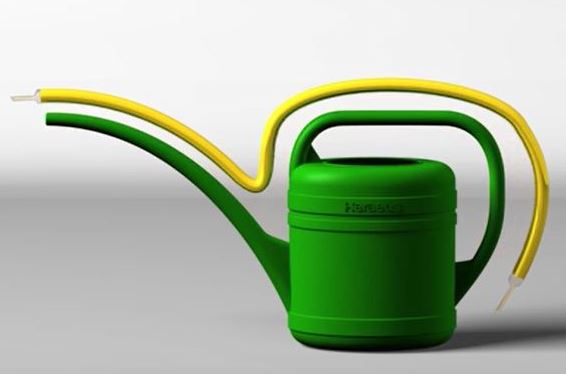Infrared heat helps to get a good grip

Steering wheels, watering cans and handles shall have a good grip. On no account must they have sharp edges. However, sharp burrs cannot always be avoided when producing plastic parts.
These burrs should be removed reliably and automatically, with not much energy and time consumed by the process.
Infrared emitters, precisely aligned to contours, edges and borders use energy very purposefully.
Heating plastics in seconds, without contact, and in a targeted manner
The wide range of processes used in plastics processing can now be carried using infrared heating technology. Infrared emitters are already well-established in the rapid, homogenous heating of large, flat surfaces.
However, there is a real challenge in manufacturing processes where only very small or curved surfaces, edges, borders or defined contours of the product need to be heated. Why is it necessary to heat up complete car doors, steering wheels or foot mats when only a few centimeters of these products require heat.
Plastics welding and deburring with Infrared heat
Plastic components can be joined by infrared heating without the need for adhesives or other joining mechanisms. The infrared radiation melts a thin surface layer of the individual plastic parts in a short time. The parts are then joined by simply pressing them together to form products such as windscreen washer water or brake fluid reservoirs. In contrast with contact welding using hot plates, no excess material clings to the heat source and heating stage takes place in seconds and is repeatable.
Plastic handles, housing parts, air intakes or covers are often injection moulded. Very often it is impossible to prevent the creation of sharp-edged burrs, especially in the tool separation plane. Shaped infrared emitters precisely melt away only the burr, without damaging the actual work piece.
As a result, they are superior to many conventional methods, such as manual removal with special blades or by the use of gas flames, which do not produce repeatable results and take considerable time.
Our video shows how the deburring of plastic parts can be improved!
Contact Dr. Marie-Luise Bopp
+49 6181 35 8547
Heraeus Noblelight GmbH
Heraeusstraße 12-14
63450 Hanau
Germany
Tel.: +49 (0) 6181 35-8492
Fax: +49 (0) 6181 35-16 8492
Email: hng-info@heraeus.com
Media Contact
All latest news from the category: Process Engineering
This special field revolves around processes for modifying material properties (milling, cooling), composition (filtration, distillation) and type (oxidation, hydration).
Valuable information is available on a broad range of technologies including material separation, laser processes, measuring techniques and robot engineering in addition to testing methods and coating and materials analysis processes.
Newest articles

Bringing bio-inspired robots to life
Nebraska researcher Eric Markvicka gets NSF CAREER Award to pursue manufacture of novel materials for soft robotics and stretchable electronics. Engineers are increasingly eager to develop robots that mimic the…

Bella moths use poison to attract mates
Scientists are closer to finding out how. Pyrrolizidine alkaloids are as bitter and toxic as they are hard to pronounce. They’re produced by several different types of plants and are…

AI tool creates ‘synthetic’ images of cells
…for enhanced microscopy analysis. Observing individual cells through microscopes can reveal a range of important cell biological phenomena that frequently play a role in human diseases, but the process of…





















